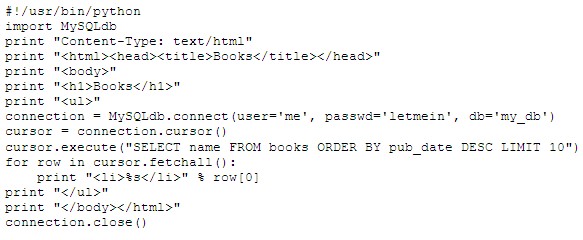Django is a prominent member of a new generation of Web frameworks. So what exactly does that term mean?
To answer that question, let’s consider the design of a Web application written using the Common Gateway Interface (CGI) standard, a popular way to write Web applications circa 1998. In those days, when you wrote a CGI application, you did everything yourself — the equivalent of baking a cake from scratch. For example, here’s a simple CGI script, written in Python, that displays the ten most recently published books from a database:

This code is straightforward. First, it prints a “Content-Type” line, followed by a blank line, as required by CGI. It prints some introductory HTML, connects to a database and executes a query that retrieves the latest ten books. Looping over those books, it generates an HTML unordered list. Finally, it prints the closing HTML and closes the database connection.
With a one-off dynamic page such as this one, the write-it-from-scratch approach isn’t necessarily bad. For one thing, this code is simple to comprehend — even a novice developer can read these 16 lines of Python and understand all it does, from start to finish. There’s nothing else to learn; no other code to read. It’s also simple to deploy: just save this code in a file called latestbooks.cgi, upload that file to a Web server, and visit that page with a browser. But as a Web application grows beyond the trivial, this approach breaks down, and you face a number of problems:
- What happens when multiple pages need to connect to the database? Surely that database-connecting code shouldn’t be duplicated in each individual CGI script, so the pragmatic thing to do would be to refactor it into a shared function.
- Should a developer really have to worry about printing the “Content-Type” line and remembering to close the database connection? This sort of boilerplate reduces programmer productivity and introduces opportunities for mistakes. These setup- and teardown-related tasks would best be handled by some common infrastructure.
- What happens when this code is reused in multiple environments, each with a separate database and password? At this point, some environment-specific configuration becomes essential.
- What happens when a Web designer who has no experience coding Python wishes to redesign the page? Ideally, the logic of the page — the retrieval of books from the database — would be separate from the HTML display of the page, so that a designer could edit the latter without affecting the former.
These problems are precisely what a Web framework intends to solve. A Web framework provides a programming infrastructure for your applications, so that you can focus on writing clean, maintainable code without having to reinvent the wheel. In a nutshell, that’s what Django does.

